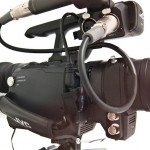The JVC GY-HMQ10 is a new 4K camcorder, which captures the full 3840 x 2160 resolution at 24p, 30p and 60p frame rates. Yeah, 60p at 4K…
The HMQ10 features a 1/2.3″ CMOS sensor at a true 8.2MP for pixel-to-pixel rendering of the 4K image. It is equipped with a fixed 10x zoom lens with an f/2.8 minimum aperture (f/4.5 at full tele).
Check out this quick overview video from the CES 2012 show floor.
The camera records to SD-format memory cards via 4 (yes, 4 separate) SDXC card slots. There are also 4 HDMI ports for sending a live 4K signal out from the camera. JVC was piping the signal from one camera to a 4K monitor on display on the show floor. Seeing a video signal that’s 4x the resolution of full HD from a sub-$5000 camera is pretty amazing stuff.
The HMQ10 uses the Falconbrid processor, which was unveiled at last CES 2011 alongside a concept version of the HMQ10. The HMQ10 uses an MPEG-4 AVC/H.264(.MP4) for 4 stream separate recording 60fps/50fps/24fps progressive at 144Mbps.

We didn’t get into details of the workflow; however, there is some assembly required for putting the streams together in post. JVC includes the appropriate software with the HMQ10 for assembling the four separate files into a final 4K file.

I took a close look for several minutes at one of the 4K monitors that was playing footage from the HMQ10. There is obvious compression in the final output file. JVC gets its quoted 144Mbs data rate by multiplying the individual segments by four, which turns out to be the equivalent of a single 36Mbps HD stream. In that case, it’s easy to understand why the compression is so obvious at full resolution.
What’s interesting though, is that the HMQ10 provides an uncompressed signal out of the HDMI. Again, workflow concerns me a bit. I’m not aware of any quad-HDMI capture devices, so I guess we would use an array of 4 Atomos Ninjas, AJA KiPros or Hyperdeck Shuttle 2’s. (Let me know if you are aware of a better capture solution for this setup.) Then, there’s post assembly of the uncompressed files. If the included JVC software utility can handle assembly of the uncompressed files, then all should be well and good. I’m still unclear on how that goes.
That said, the resolution is, again, impressive. Several shots were obviously taken in and around Vegas – probably in the days leading up to CES. A 4K image is just astoundingly sharper than what we’re accustomed to viewing in our living rooms. I’m guessing the 4K monitors I watched were in the 42″ to 46″ range. From a normal viewing distance of 6-8+ feet away, the image was very impressive.
The HMQ10 also shoots 1080p HD footage at 24/30/60 fps. Additionally, there are time lapse options available at 4K.
The takeaway here is that JVC has put together a 4K camcorder for under $5,000, which is a big first and carries a wow-factor with just the headline. The images I saw and camcorder form-factor seem to be well-worth the asking price; however, there are plenty of limitations as noted above. If you aren’t ready to invest in an appropriate capture system for the uncompressed signal, you are going to be limited in what you can do with any grading after the fact. Unless there’s a reason to rock the 4K image for your clients (be it delivery or re-framing in post), then that $5K might be better spend elsewhere until the 4K market finds its feet.
The JVC GY-HMQ10 should be available in March 2012 at an initial retail price of $4995. It’s listed here on B&H.

Speaking of the growing 4K market, JVC also showed off an interchangeable lens camera that features a Nikon F-mount and a larger 1.25″ 4K CMOS sensor.

There’s not much to say about it. I didn’t get any hands-on time with it because it was under the glass; however, it basically looks like a big brother to the HMQ10.

The fact that it accepts Nikon F-mount lenses is exciting due to the volume of F-mount lenses in the world. Plenty of F-mount lenses with aperture rings too. I’m not sure about whether electronic aperture control is an intended function of the camera.

The sensor size should be enough to get some decent bokeh for that cinema feel. And it has upgrades to SDI ports.
The HMQ10 sure looks a lot like the concept model we saw at CES 2011, so if that’s anything to go by we could see this interchangeable lens model showing up by next year. However, the JVC rep did stress that anything could change on the camera, and specifically noted that the Nikon F-mount was just what they were currently testing.
Loads of images in the gallery below. The comments are also open for discussion below the gallery.











































This still seems like a proof of concept camera to me, don’t get me wrong i’m liking it but just seems a little rushed.
Why 4 seperate SD cards for 36Mbps? Combining those sounds like a hassle. Plus 36Mbps is far too low for 4k, they should have put a high speed SSD in and then you could have much higher bitrates and no messy 4x stream combining to do.
Very informative article post.Thanks Again. Want more.
please release with best price
This is one awesome post.Much thanks again.
Does it shoot at 30P?
It’ll do HD at 60i, which should yield 30p off the sensor and in your NLE. 4K is limited to 60p, 50p and 24p.